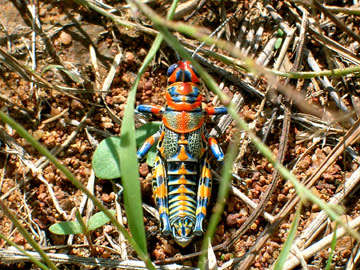
Patagonia Mountains near Harshaw Creek
Every year, Thursday of the Invertebrates in Captivity Conference is field trip day. It’s one of my favorite parts of the trip. For one thing, it divides the attendees into much smaller groups, which makes it a great way to get to know the new folks. This year, the field trip that I chose had three distinct destinations: Harshaw Creek, Empire Cienega, and Florida Canyon.

The hills are alive- with entomologists
We got to Harshaw Creek about 8:30 in the morning. This segment of the trip illustrates one of the challenges of collecting at this year’s conference. It had rained heavily through the pre-dawn hours. The vegetation was wet and the air still chilly when we got there, so there wasn’t much flying. I feel like I spend most of the entire week with damp socks. Still, the scenery was beautiful, the company was engaging, and we did manage to find a few good things.

Bagworm cocoon at Harshaw Creek

Fence Lizard
We got to Empire Cienega right around lunchtime. By this point, the weather was again touch and go. Empire Cienega is a desert wetland, but it’s also a historic site that’s being renovated. On the way in, we ran into one of the archaeologists. He suggested that we keep a close eye on the weather, and leave if the rain got heavy. For about an hour, the sun was in and out, and the collecting wasn’t half bad. Lots of folks got vinegaroons, but alas I got no photos. Right when we were ready to eat, the skies opened. Heeding the archeologist’s advice, we managed to get all 27 entomologists back into the cars and on our way in no more than five minutes. What we didn’t know was that it had been raining heavily upstream from us for some time. One of the washed between the highway and us was in full flood when we got there. We were trapped (though in no danger) along with the archaeologists. Abruptly, the weather improved. We stood around for about an hour waiting for the creek to go down. Eventually, it dropped enough for the high-clearance vehicles to pass. About 20 minutes later, the flood had subsided to the point that even the rental cars could cross.

This picture doesn't really capture how deep the water was, nor how swift the current

The water has already dropped over a foot here. It would be another
20 minutes before the passenger cars ventured across
We reached Florida (pronounced flo-REED-a) Canyon high in the Santa Rita Mountains around 2. The sun shone brightly the whole time we were there. Clouds of thousands of bordered patch butterflies lined the roads. The monsoon season has been so heavy this year, that the canyon stream was virtually a river and not crossable. Still, we had a nice time collecting there and I managed to get a nice selection of Chrysomelid beetles. The trip ended in time to get home for the keynote speech, which was about a really cool type of insect called a velvet ant. More about them later.

Florida Canyon with lots of water in the wash

Arizona Rainbow Cactus
Labels: Arizona, Collecting, Travel




































